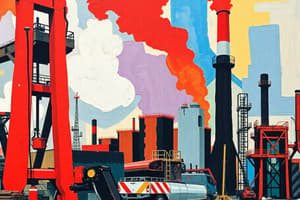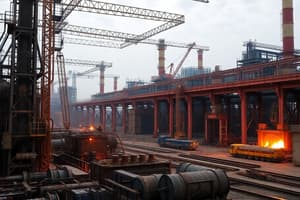Podcast
Questions and Answers
What was one of the main reasons for relocating the iron and steel industry inland?
What was one of the main reasons for relocating the iron and steel industry inland?
The coastal areas were less populated than the inland regions during the shift of the iron and steel industry.
The coastal areas were less populated than the inland regions during the shift of the iron and steel industry.
False
What movement was associated with the inland relocation of industries in China?
What movement was associated with the inland relocation of industries in China?
The Third Front Movement
The industry aimed to reduce costs by establishing factories closer to _____ and _____ mines.
The industry aimed to reduce costs by establishing factories closer to _____ and _____ mines.
Signup and view all the answers
Which of the following was NOT a reason for the shift of the iron and steel industry inland?
Which of the following was NOT a reason for the shift of the iron and steel industry inland?
Signup and view all the answers
Match the reasons for relocating the iron and steel industry with their descriptions:
Match the reasons for relocating the iron and steel industry with their descriptions:
Signup and view all the answers
The relocation of the iron and steel industry only aimed to industrialize urban coastal areas.
The relocation of the iron and steel industry only aimed to industrialize urban coastal areas.
Signup and view all the answers
What was the primary reason for the relocation of the iron and steel industry during the 1950s to the 1970s?
What was the primary reason for the relocation of the iron and steel industry during the 1950s to the 1970s?
Signup and view all the answers
The inland shift of the iron and steel industry was largely a random decision.
The inland shift of the iron and steel industry was largely a random decision.
Signup and view all the answers
What were the two major goals of relocating the iron and steel factories to inland regions?
What were the two major goals of relocating the iron and steel factories to inland regions?
Signup and view all the answers
China's iron and steel industry was primarily concentrated in the __________ before the 1950s.
China's iron and steel industry was primarily concentrated in the __________ before the 1950s.
Signup and view all the answers
Which region was considered vulnerable to attacks during the 1950s to 1970s?
Which region was considered vulnerable to attacks during the 1950s to 1970s?
Signup and view all the answers
How did the relocation of factories aim to address the issue of overpopulation?
How did the relocation of factories aim to address the issue of overpopulation?
Signup and view all the answers
Factories were moved to the interior regions to increase __________ levels in those less-developed areas.
Factories were moved to the interior regions to increase __________ levels in those less-developed areas.
Signup and view all the answers
Match the following reasons for the inland shift with their descriptions:
Match the following reasons for the inland shift with their descriptions:
Signup and view all the answers
Study Notes
The Inland Shift of China's Iron and Steel Industry (1950s-1970s)
- China's iron and steel industry relocated from coastal areas (like Anshan) to inland regions between the 1950s and 1970s.
- This shift was driven by government policy, aiming for both strategic protection and economic development.
Government Policy as a Driving Force
- China's state-planned economy (centralized government control) determined industrial location decisions.
- The relocation aimed to protect the industry from potential attacks during wartime.
- The government sought to boost economic development in less-developed inland areas.
Strategic Reasons for the Shift
- The central government worried about enemy attacks on coastal factories.
- Moving industries inland reduced their vulnerability to enemy action.
- Protecting the industrial backbone was a priority.
Economic Reasons for the Shift
- Less-developed inland regions faced lower economic development and living standards.
- The government sought to improve economic conditions and job creation in inland regions.
- Overpopulation in coastal areas was another contributing factor.
Practical Reasons for the Shift
- Transportation costs were lower by moving factories closer to raw materials (coal and iron ore) located inland.
- Early inland transport links were less developed than coastal ones; this created logistical challenges for transporting finished products.
The Third Front Movement (Sanxian Jianshe)
- The inland relocation was part of a larger national policy effort for building factories, infrastructure, and industries in remote, mountainous regions to strengthen China's national defense and economy,.
Studying That Suits You
Use AI to generate personalized quizzes and flashcards to suit your learning preferences.
Related Documents
Description
This quiz explores the significant relocation of China's iron and steel industry from coastal areas to inland regions during the 1950s to 1970s. It focuses on the government policies that drove this shift, along with the strategic and economic rationale behind these decisions. Test your knowledge on the impact of this transformation on China's industrial landscape.




